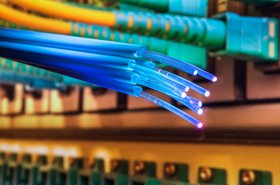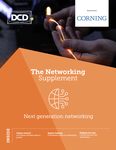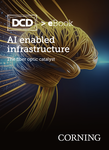As next-generation technologies and high-performance computing continue to surge, networks are under more pressure than ever to keep up with rising connectivity demands. While power, cooling, and land have dominated the conversation so far, Brian Rhoney – with 24 years of experience at Corning in the telco space – takes a deep dive into the network infrastructure underpinning the digital infrastructure sector.
Past: Revisiting predictions
Looking back at industry forecasts from 2020, Rhoney recalls predicting that the demand for connectivity within data centers – particularly to support AI-driven compute nodes – would be significant. Even then, large-scale expansion was already well underway to accommodate this surge.
Thinking back further to the late 1990s and early 2000s, the prevailing belief was that existing fiber infrastructure would be sufficient for the foreseeable future. At the time, few anticipated the explosive growth of cloud computing, streaming, and AI-driven applications, all of which have pushed networks to their limits.
“I think we’re getting to the point where that’s starting to happen – and maybe a little quicker than we thought,” he reflects.
Connectivity inside the data center
With the exponential growth of data, driven by AI’s increasingly dense workloads, there is a pressing need to optimize how this data moves to prevent system overload.
In the UK, for example, the rapid emergence of alternative fiber providers has led to an oversupply of fiber in some areas. However, this abundance hasn’t necessarily translated into an efficient distribution model. Higher-level bodies, including government and public sector organizations, have a critical role in optimizing fiber and connectivity allocation to ensure a sustainable and effective model.
Inside the data center, AI applications typically operate in two key phases – training and inferencing – each requiring vast amounts of data. CPUs and GPUs perform the heavy-duty computation needed to train AI models, which are later used for inference. As Rhoney highlights, these processes don’t happen in isolation; they depend on robust connectivity to link devices within the data center:
“We rely on a vast array of devices working together to handle the heavy compute required for training AI models, which later powers inference through parallel processing.”
This connectivity is not only dense and highly interwoven within individual data centers but also extends across multiple facilities, ensuring seamless data flow on a massive scale.
Present: AI’s impact on network needs
With much of the AI workload concentrated in the US, the long-term impact on capacity and data sovereignty will become clearer as AI models are increasingly trained at regional levels.
The growing number of data-generating devices in major cities, especially in the US, raises questions about the sheer scale of data consumption. Everyday items, like smart fridges notifying us to restock milk and wearables tracking our every move, demonstrate the shift.
The ability of data centers to move data between them, especially across major cities, is nearing its limits, signaling a need for stronger core infrastructure. Rhoney emphasizes the importance of focusing on connectivity, not just power:
“The reality is, we’re reaching the theoretical limit of how much data we can move over that element – the ‘Shannon limit.’”
He warns that solving the power problem alone won’t be enough:
“If you only solve the power problem, you’ll end up falling behind on the network front, and addressing the network problem without considering power won’t support the GPU density required to process all this data.”
Future: Bridging the digital divide
As Rhoney looks to the future, he believes the focus shouldn’t just be on individual data centers, but on the broader infrastructure needed to support the explosive movement of data. A key part of this is modernizing the cables that were laid in the 90s, upgrading them to the infrastructure we need today.
To address this challenge, it’s crucial to remain vigilant, continuously evaluate past infrastructure, and analyze geographic maps to ensure diverse connectivity between key endpoints.
We’ve all faced poor connectivity when we feel it matters most – whether during a phone call on a train, mobile banking, or streaming issues – Rhoney emphasizes. However, he stresses that the digital divide goes far beyond these everyday inconveniences.
Access to low-latency connectivity can significantly impact residents’ access to healthcare and education, for instance. This divide isn’t just present in rural areas; it extends between metropolitan regions, where some rural areas are still underserved.
Emerging fiber technologies
Today, various broadband technologies – including fixed, wireless, satellite, and fiber-to-the-home – keep us connected. While each has its place, Rhoney is confident that fiber will be the backbone of future network expansion. Satellite and fixed wireless are valuable solutions for remote areas where fiber deployment isn’t economically viable, but for most cases, fiber remains the superior option.
However, expanding fiber networks comes with challenges, particularly related to labor and cost. Rhoney emphasizes the need for innovative deployment strategies:
“The continued push for fiber connectivity is imperative, and we must be innovative in how we deploy it, making the process easier, faster, and more cost-effective in key areas.”
He also highlights emerging fiber technologies, specifically hollow-core (or anti-resonant) fiber, which has the potential to reduce latency:
“These technologies won’t necessarily expand connectivity to more people, but they will enhance latency-sensitive applications. It’s still in its early stages, but interest in our industry is growing.”
Predictions: Video and AI driving connectivity in 2025
According to Rhoney, the future of connectivity will be shaped by two major forces: video and AI. These technologies will drive the need for better infrastructure, and his two key predictions for 2025 and beyond focus on:
- Video as a primary driver of connectivity
- Closing the digital divide
On the video front, Rhoney anticipates that video content will fuel the next major surge in data demand, particularly within and between data centers. He explains:
“That drives up the cluster sizes needed to generate these complex videos, and these applications will push connectivity advancements. I believe this will be the next major driver of connectivity.”
The consensus is that as AI evolves, it will increasingly rely on various data types – graphical images, voice data, and, most significantly, video. As AI begins using video to learn, the resulting data traffic within data centers will grow exponentially.
Turning to the digital divide, Rhoney highlights initiatives, particularly in the US, aimed at expanding broadband access, such as the broadband equity, access, and deployment (BEAD) program:
“It’s been a slow build, but plans are finally coming together. I hope to see real progress in closing the digital divide, ensuring that as video content continues to evolve, everyone has access.”
Wrapping up, Rhoney remains optimistic about the future of connectivity, driven by growing data demands, the expansion of video applications, and continued efforts to bridge the digital divide. He highlights that connectivity is vital not only for entertainment but also for essential services like education and healthcare. However, he stresses the urgent need to inspire and educate more individuals to build, maintain, and innovate within the networks that will power the future.
To find out more about how AI is impacting connectivity, download Corning’s Nvidia 800G InfiniBand and Ethernet connectivity AI cabling guide.
More from Corning


Sponsored
Five questions to consider when building your data center migration strategy
Ensuring a flexible and cost-effective strategy for 400G and 800G transceivers with these critical considerations

Sponsored
Intelligent structured cabling will future-proof the age of AI
AI has made 800G an aspiration, not a nice to have
Read the orginal article: https://www.datacenterdynamics.com/en/marketwatch/the-devil-is-in-the-data-expanding-networks-to-handle-the-ai-surge/




